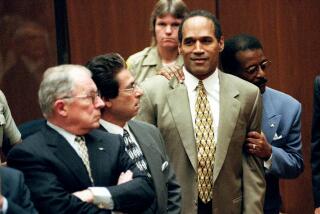Quick Verdict Shows Prosecutor Failed to Woo Jurors : Smith trial: Moira Lasch did not establish any emotional ties with the jury--and, consequently, with the alleged victim.
- Share via
The trial of a major case is in part a drama and in part a love affair in which your job as a trial lawyer is to woo the jurors and convince them to identify with you and, through you, with your client.
The fact that the jury in the William Kennedy Smith case returned its verdict after less than two hours of deliberation proved dramatically that prosecutor Moira K. Lasch failed utterly to establish such a relationship.
A verdict so quick goes beyond being a defeat; it is an insult.
Defense lawyer Roy E. Black summed up the courtroom dynamics when he told the jurors in his closing statement that he felt honored to have “worked with you” in the case. And that was precisely what was happening. From the moment they were carefully selected, the jurors had been working with Roy Black. Lasch, by contrast, seemed never to form a bond with either the jury or the alleged victim.
Perhaps Lasch never believed that doing so was properly part of her job. Most of the time, prosecutors worry far less about creating emotional ties than do their colleagues in the defense bar. After all, prosecutors like to say and believe, the client is not the complaining witness, but the state itself.
In most run-of-the-mill cases, that position may be correct. But this was not a typical case. In a rape case such as this, a case where the issue is not whether the defendant and the alleged victim had sex, but whether the sex was consensual, two people are on trial. And in this case, only one of those people appeared to have an advocate.
That fact is in one sense unfair to Smith. Although he has now been acquitted, a nagging doubt will always remain in the minds of many who watched the trial: Is this a case that was inherently so weak that it never should have been brought to court, or could another prosecutor have obtained a different result?
But at the same time, the result was deeply unfair to the alleged victim. For at the time when she most needed an advocate, her only lawyer was a prosecutor whose questions seemed to indicate that she was offended not only by rape, but by casual sex and those who engage in it. At the time when the alleged victim most needed someone to stand by her, she was alone.
Looking back through the trial, one can see how that lack of a bond between the two women who were at the center of the drama, coupled with the gap in resources between the state and the defense, devastated the prosecution’s case.
When Smith took the stand, for example, the defense had prepared him so that every possible inconsistency in his statement had been carefully thought through and an answer prepared for every possible question. To my mind, Smith’s performance recalled a case I worked on some years ago assisting the late Edward Bennett Williams in which I spent two entire months, eight hours a day, doing nothing but preparing a defendant to take the stand.
By contrast, when the alleged victim testified, the prosecution seemed simply to throw her before the jury to fend for herself as best she could. No work was done to figure out answers to obvious questions her statements raised, most notably the question Black asked at the end of the case: “Who is Michael?”
Black heightened the difficulty for the prosecution by a masterful defense strategy. In many cases, a defense lawyer lays out much of the strategy of his case in his opening statement. And even when he does not do that, most defense lawyers have made clear where they are headed by the time they finish their cross-examination of the prosecution’s main witness.
Not here. Although Black’s questioning of the alleged victim carefully picked away at the inconsistencies in her many statements, he avoided asking her questions that revealed what Smith would say about the events of March 29 and 30 when he took the stand. As a result, the details of Smith’s testimony came to the prosecution as a fresh revelation, something they had minimal time to prepare for.
The defense strategy, however, actually began with the three-week jury selection in which the defense succeeded in obtaining the sort of jury it wished. Normally, working with the sort of stereotypes that trial lawyers use in jury selection, defense lawyers will try to load the panel with liberals, believing them to be sympathetic to defendants.
Here, by contrast, Black was looking for, and got, conservatives and Catholics, people unlikely to sympathize with a young woman who had left her child behind to go out drinking at a bar where she met a man and went home with him at 3 in the morning.
This was a jury that would be willing to empathize with the alleged victim only if her advocate could charm them into doing so. And Lasch was the wrong person for that job.
More to Read
Sign up for Essential California
The most important California stories and recommendations in your inbox every morning.
You may occasionally receive promotional content from the Los Angeles Times.










